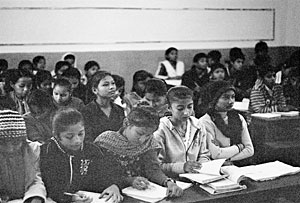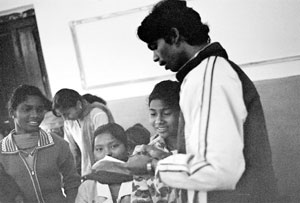 PETER SUTORIS |
As I flew into Nepal and was greeted by the sight of mountains obscured by clouds of dust above a chaotic spread of buildings, vehicles, and human beings, I couldn't help but wonder what difference my short internship with an education-oriented NGO would make. Little did I know these first impressions of sharp contrasts and striking diversity, obscured by dust, would mirror my experience of Nepali education and convince me that thinking globally about reforming Nepali schools requires 'watching locally'.
Most would agree that it is necessary to provide equal access to quality education for underprivileged children. Unfortunately, many of the large-scale top-down education reforms of the last few decades have used approaches akin to deploying jackhammers on nails. The universal, one-size-fits-all model promoted by these reforms ignores the ethnic, cultural, economic and geographic diversity of Nepali students. My internship with The Learning Center of Kathmandu (TLC), which is staffed by four Nepalis and has an annual budget of under US$20,000, demonstrated how small, targeted programs can effect significant change.
It's 6am in Maheshpur, Jhapa. Uniformed students emerge from the morning mist. Some have cycled from 15km away, and classrooms are filled by 6.30am. The stage is set for two hours of Partners In Education (PIE) tutorials. The program pairs committed private school teachers with underperforming, albeit promising, public school students in grades 8-10 for tutorials in the three most problematic subjects � English, Math, and Science. It currently provides free tutoring to more than 300 children in Jhapa. Since its inception five years ago, not a single PIE-tutored student has failed the SLC, an impressive 100 per cent success rate compared to the national average of 40 to 60 per cent. And the cost to donors? Less than US$4 per student per month.
 |
Raphael Pradhan, the head of TLC, has similar questions. He cites the example of Tara Bahadur Waiba. Tara was a domestic labourer before joining PIE in 2006. Completing three years of tutoring enabled him to secure an impressive higher second division result in the SLC. "He even received the 'Most Regular Student Award' which TLC gives out annually for recognition of student dedication. Despite the handicap of coming from a financially poor background, he had the zeal to further his studies and improve his living standards," Raphael remembers. Today, Tara is studying in Bhairahawa and aspires to become a Health Assistant in dentistry. "I would like to see more poor and underprivileged students receive extra help so that they can at least complete high school and stand on their own two feet, just like Tara did," Raphael says.
 |
PIE will not solve the underlying problems of the Nepali education system, but it does promise more concrete results for individual students than many larger programs. So far aid agencies and government have not hit upon the right mix of interventions for education in the developing world. In the meantime, programs like PIE can help close the gaps. With public support, targeted programs can be sustained and scaled up to reach the widest possible range of beneficiaries.
Support TLC and PIE at www.tlc-nepal.org
READ ALSO:
Enjoy the silence, RABI THAPA
Keeping the peace, KASHISH DAS SHRESTHA


